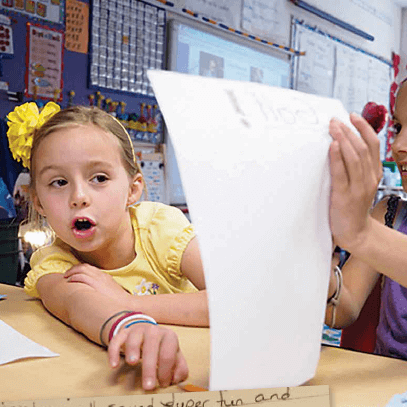This Colorado Academy third grade student’s letter to her parents can’t help but make you smile.
“Dear Ma,
“Monday morning we had our first town meeting with our kindergarten buddys
[sic]. My buddy is sooo cute. Her name is Emily. She is kind of shy. Lunch was terrible! Wink wink. All we got was ….. pancakes, sprinkles, chocolate chips, and whipped cream!
“Oh and ham!
“We were the only people at school that day because the other classes were at the P.C.C. (Plains Conservation Center, a third grade overnight trip connected to the class’s curriculum on the history of Colorado).
“Oh speaking of the P.C.C., I NEED to pack.
“I’m sooo excited to go to the P.C.C.
“Love,” your child
And as the custom at CA, her parents wrote back.
“Hello my beautiful daughter. I am so happy that you are enjoying your buddy so much. It was nice to learn about her — how sweet she is, how much she looks like her sister, how fun it is to be her 3rd grade special buddy. I hope I get to meet her soon!
“How delicious to have pancakes for lunch at school! I bet it was a great surprise.”
There’s more, but you get the idea. Many say the art of letter writing is disappearing, as the world finds it easier to send texts, emails and tweets. Alas, much of those hurriedly written works lack heart.
“At the end of the year, we’ll go back and look at their first letters. They may say, ‘I can’t believe that’s what I wrote.’ ”
So Lower School teachers Lori Noricks (third grade) and Jessica McCoy (second grade) work hard to instill a love of writing letters in their students. They have students write almost-weekly letters to their parents — or on occasion, their siblings, grandparents, even the family dog — telling them about their school activities. In return, the parents write back a letter. And yes, they’ll pinch-hit for the dog, handling its response as well.
In the process, the teachers make sure the students learn about how to select writing topics, the format, sentences, paragraphs, spelling — everything that good writing requires.
“We’ve stopped writing letters,” Noricks says. “With technology and all, kids just don’t know how to do it.”
Each student keeps a notebook that holds their letters and the responses. “They love writing to their parents, and parents respond, and the children bring back their journal notebook on Monday,” Noricks says. “Sometimes they’ve read the parents’ letter, sometimes not. We give them a chance to read the letter, then put the notebook away until the next Friday.”
Of the second graders, McCoy says, “It’s also a great practice for them to learn the different elements within a letter and how to write a letter correctly, because it’s kind of a lost art form these days. It’s also a great way for them to communicate and encourage discussion with their family about what they’re doing in school.
Sometimes they’re asked what they did in school and say, ‘Nothing.’ This provides a wonderful prompt to elicit details from the day.”
McCoy requires each student to pick three ideas to include in their letters, drawing from what they’ve been doing at school. As the school year progresses, she makes sure they add more details.
“It’s a keepsake,” McCoy says. “They can look back, see all of the things they’ve done.”
The second graders write in manuscript; the third graders learn to write in cursive during the year. The second graders learn the fundamentals, and Noricks makes sure the third graders learn more of the key elements of good letter writing.
“A lot of the language arts curriculum is written into the letter-writing campaigns,” Noricks said. “How to set up a letter. What does a paragraph look like? What does a paragraph include? Punctuation, capitalization, topic sentences, supporting sentences, vocabulary, complete sentences.
“If a topic sentence says, ‘We had so much fun in PE today,’ we look into supporting that with examples.”
She enjoys seeing the students improve through the school year. “It is quite noticeable,” Noricks says. “At the end of the year, we’ll go back and look at their first letters. They may say, ‘I can’t believe that’s what I wrote.’ ”
